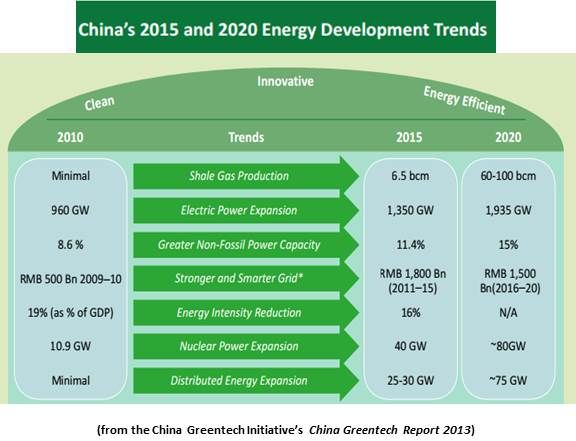China can realize the ambitious targets in its twelfth 5-Year Plan by shifting its focus from increasing capacity to managing demand, according to a just-released report from the China Greentech Initiative, The 2013 China Greentech Report: China at a Crossroads.
“China has a strong track record of achieving supply-oriented targets for energy and electric power,” the report observed. “From a demand perspective, a fundamental shift in emphasis from increasing capacity to managing demand and promoting energy savings is essential.”
“As the world’s largest energy consumer and with reliance on foreign oil, coal, and gas growing, China is facing mounting pressure,” the report also said. But China's unconventional natural gas reserves and unprecedented renewables growth can relieve that pressure.
The latest Five-Year Plan devised for the world’s second biggest economy once again laid out the kind of ambitious energy targets that China has been successful at hitting:
- In wind: Get to 100 gigawatts of installed and grid-connected wind power capacity by 2015
- In solar: The original target of 10 gigawatts was raised three times since the plan was published and is now at 35 gigawatts of installed and connected solar by 2015
- In “other” non-fossil fuels: Increase to 11.4 percent of the national energy mix by 2015
- In natural gas: Increase to 8 percent of the national energy mix by 2015 and 10 percent by 2020
- In energy efficiency: Reduce energy intensity 16 percent below 2010 levels and cap annual energy consumption at 4 billion tons of coal equivalent by 2015
- In air quality: Cut carbon intensity 17 percent, sulfur dioxide emissions by 8 percent, nitrogen oxides by 10 percent and particulate matter by 15 percent by 2015
- In financial mechanisms: Experiment with carbon taxes and carbon trading markets

Growing demand is the way to meet these new targets, according to the report. China’s new challenge is to iron out technical, regulatory and commercial obstacles obstructing demand management. Regulatory and commercial challenges “have major implications for the energy sector,” the report said.
Regulatory improvements should include stricter environmental standards and enforcement mechanisms, especially in air and water quality.
Commercial improvements should include government-established electricity price reforms that drive the use of energy-efficient technologies.
China’s natural gas reserves, 96 percent unconventional, are in coal bed methane, coal mine methane and shale gas. Commercialization offers China a rich economic opportunity, but will also, the report noted, require regulation to minimize environmental impacts.
The report offered a three-stage roadmap for China:
- 2013 to 2014: Pilot projects
- 2015-2017: Large-scale development
- 2020 onward: Widespread adoption

To meet its challenges and sustain its economic growth, the report said China must:
- Meet or exceed its non-fossil fuel targets
- Develop its gas resources by getting global expertise in production processes and environmental impact management
- Promote efficient energy use, especially in the industrial and building sectors
- Accelerate smart grid plans already in the works at State Grid and Southern Grid
- Drive innovation and transparency with technologies, business models and operational changes that make demand, supply, pricing, assets and other information available to enable collaboration and effective decision-making.
China can go a long way toward meeting its needs with a newer, bigger smarter grid: “An improved grid can result in enormous energy savings through demand management, greater accuracy in energy use projections, and improved integration of renewable energy sources,” the report said.
The China Greentech Initiative is a collaborative platform of Chinese and international organizations focused on deploying greentech solutions in China. It has published a report on China annually since 2009.



